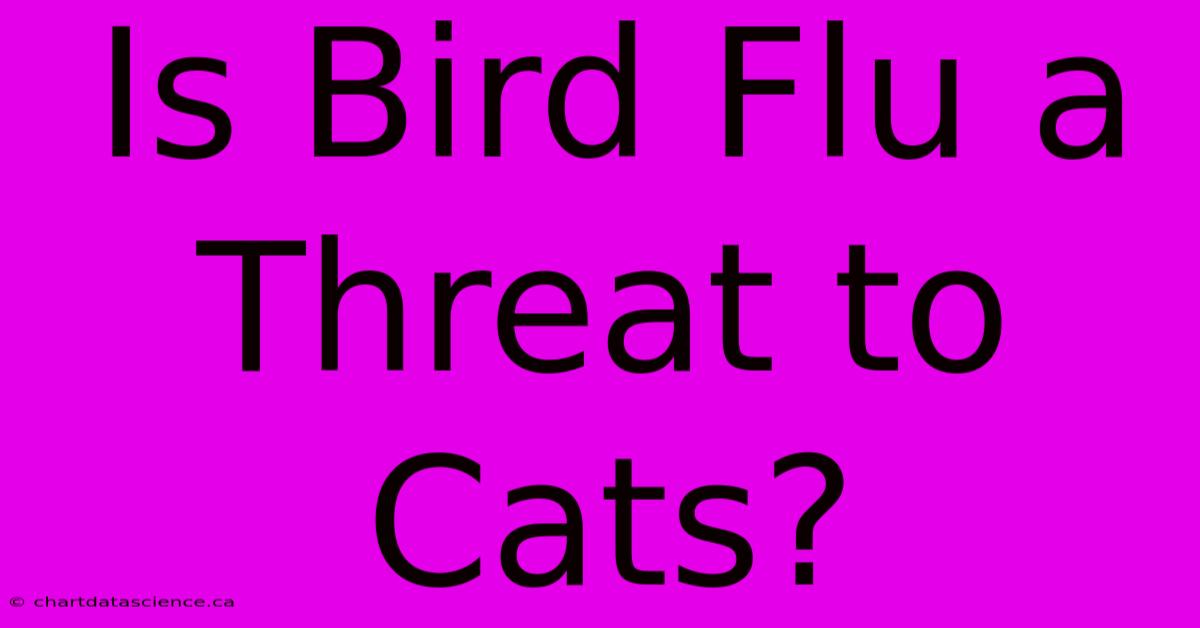Is Bird Flu A Threat To Cats?

Discover more detailed and exciting information on our website. Click the link below to start your adventure: Visit My Website. Don't miss out!
Table of Contents
Is Bird Flu a Threat to Cats? Understanding Avian Influenza and Feline Risk
Avian influenza, commonly known as bird flu, is a highly contagious viral infection affecting birds worldwide. While primarily affecting poultry and wild birds, recent cases have raised concerns about the potential risk to other animals, including cats. This article explores the threat of bird flu to cats, examining transmission, symptoms, and preventative measures.
Can Cats Get Bird Flu?
Yes, cats can contract avian influenza, though it's not as common as in birds. While the virus doesn't typically spread easily between cats, direct contact with infected birds or contaminated environments poses a risk. This means exposure to infected bird droppings, feathers, or carcasses significantly increases the chance of infection.
How Do Cats Contract Avian Influenza?
The primary mode of transmission for cats is direct contact with infected birds or their bodily fluids. This could involve hunting infected birds, scavenging on carcasses, or even interacting with contaminated environments. While less likely, indirect transmission through contaminated surfaces is also possible.
Risk Factors for Feline Bird Flu Infection:
- Outdoor cats: Cats that frequently hunt or roam outdoors are at a higher risk of encountering infected birds.
- Contact with poultry: Cats living on farms or near poultry farms face an increased risk.
- Exposure to infected bird droppings: Cleaning up after infected birds without proper protective gear can lead to infection.
Symptoms of Avian Influenza in Cats
Recognizing the symptoms of avian influenza in cats can be challenging, as they can mimic other feline illnesses. However, some common signs include:
- Respiratory symptoms: Coughing, sneezing, difficulty breathing, and nasal discharge.
- Gastrointestinal issues: Vomiting, diarrhea, and loss of appetite.
- Neurological signs: Lethargy, weakness, tremors, and seizures (in severe cases).
- Fever: Elevated body temperature.
It's crucial to note that these symptoms are not exclusive to avian influenza and could indicate other illnesses. Therefore, immediate veterinary consultation is essential if your cat exhibits any of these signs, especially if there's a suspected exposure to infected birds.
Diagnosing Avian Influenza in Cats
Diagnosing avian influenza in cats requires laboratory testing. Veterinarians will typically collect samples such as blood, nasal swabs, and fecal matter for analysis. Confirmatory tests are crucial to differentiate bird flu from other potential diseases.
Treatment and Prevention
Currently, there's no specific antiviral treatment for avian influenza in cats. Treatment focuses on supportive care, managing symptoms, and providing comfort. This might include intravenous fluids, medications to manage respiratory distress, and nutritional support. The prognosis depends on the severity of the infection and the overall health of the cat.
Preventing Avian Influenza in Cats:
- Keep indoor cats indoors: This significantly reduces their exposure to infected birds.
- Supervise outdoor cats: Limit their time outdoors, especially during bird flu outbreaks.
- Avoid contact with sick or dead birds: Do not allow your cat to interact with birds showing signs of illness.
- Practice good hygiene: Wash your hands thoroughly after handling your cat or anything that might have come into contact with birds.
- Clean up bird droppings carefully: Use protective gloves and disinfectants to remove droppings.
Conclusion: A Necessary Vigilance
While the risk of cats contracting avian influenza is relatively low, it's not negligible. Understanding the potential risks, recognizing symptoms, and practicing preventative measures are essential for protecting feline companions. Early detection and prompt veterinary care are crucial for the best possible outcome should your cat become infected. Always consult your veterinarian if you suspect your cat has been exposed to avian influenza or exhibits any concerning symptoms.

Thank you for visiting our website wich cover about Is Bird Flu A Threat To Cats?. We hope the information provided has been useful to you. Feel free to contact us if you have any questions or need further assistance. See you next time and dont miss to bookmark.
Also read the following articles
| Article Title | Date |
|---|---|
| Manmohan Singh Ex Pm Dies At 92 | Dec 27, 2024 |
| Kedudukan Pasukan Epl Sekarang | Dec 27, 2024 |
| Wolves Tumbangkan United 2 0 | Dec 27, 2024 |
| Squid Game Season 2 What Happened | Dec 27, 2024 |
| Lions Sign Bridgewater After Retirement | Dec 27, 2024 |
